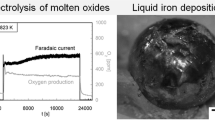Abstract
Smith's model is expanded in order to derive expressions to quantitatively describe the oxygen-solubility behavior in ternary alloys as a function of alloy composition. Multicomponent-diffusion theory is used to establish a criterion for the onset of internal oxidation beneath the external scale when oxidizing conditions favor formation of the oxide of the least-noble metal in a ternary alloy. The oxygen-solubility model and the criterion are applied to the oxidation of Ni−Cr−Al alloys in 76 torr of oxygen at 1100 and 1200°C, predicting the minimum Al concentrations required to form a protective Al2O3 scale. It shows that sufficient Cr additions would significantly reduce the oxygen solubility and also alter the oxygen distribution in the ternary alloys, avoiding the oxygen supersaturation necessary for the onset of internal oxidation. These two factors make it easier to establish the protective Al2O3 scale.
Similar content being viewed by others
References
C. Wagner,J. Electrochem. Soc. 103, 571 (1956).
P. N. Smith,Ph. D. thesis, McMaster University, 1970, p. 82.
C. Wagner,Corros. Sci. 8, 889 (1968).
W. W. Smeltzer and D. P. Whittle,J. Electrochem. Soc. 125, 117 (1978).
H. L. Toor,AIChE J. 10, 460 (1964).
J. E. Morral,Script. Met. 18, 1252 (1984).
C. S. Giggins and F. S. Pettit,J. Electrochem. Soc. 118, 1782 (1971).
G. R. Wallwork and A. Z. Hed,Oxid. Met. 3, 171 (1971).
F. A. Golightly, G. C. Wood, and F. H. Stott,Oxid. Met. 14, 217 (1980).
G. N. Irving, J. Stringer, and D. P. Whittle,Oxid. Met. 9, 427 (1975).
I. A. Kvernes and P. Kofstad,Met. Trans. 3, 1511 (1972).
J. A. Nesbitt and R. W. Heckel,Met. Trans. 18A, 2075 (1987).
J. S. Kirkaldy and G. R. Purdy,Can. J. Phys. 40, 208 (1962).
J. Park and C. J. Altstter,Met. Trans. 18A, 43 (1987).
M. S. Seltzer and B. A. Wilcox,Met. Trans. 3, 2357 (1972).
T. Yamamoto, T. Takashima, and K. Nishida,Trans. Japan. Inst. Met. 21, 601 (1980).
C. J. Smithells and C. E. Ransley,Proc. R. Soc. A155, 195 (1936).
M. Hansen,Constitution of Binary Alloys (McGraw-Hill, New York, 1958), p. 1025.
D. Janke and W. A. Fischer,Arch. Eisenhuttenwes 46, 297 (1975).
C. H. P. Lupis,Chemical Thermodynamics of Materials (Elsevier, Amsterdam, 1983), p. 470.
L. Kaufman and H. Nesor,Calphad,2, 325 (1978).
L. Kaufman and H. Nesor,Z. Metallk. 64, 249 (1973).
J. A. Nesbitt,J. Electrochem. Soc. 136, 1511(1989).
P. Kofstad,High Temperature Corrosion (Elsevier, New York, 1988), p. 368.
F. N. Mazandarany and R. D. Pehlke,Met. Trans. 4, 2067 (1973).
F. A. Elrefaie,Ph.D. thesis, McMaster University, 1979, p. 160.
N. C. Oforka and B. B. Argent,J. Less-Common Met. 114, 97 (1985).
Author information
Authors and Affiliations
Rights and permissions
About this article
Cite this article
Guan, S.W., Smeltzer, W.W. Oxygen solubility and a criterion for the transition from internal to external oxidation of ternary alloys. Oxid Met 42, 375–391 (1994). https://doi.org/10.1007/BF01046756
Received:
Revised:
Issue Date:
DOI: https://doi.org/10.1007/BF01046756




